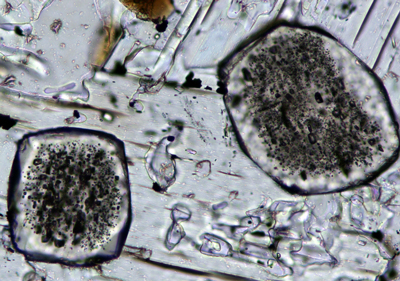Bulletin of the Geological Survey of Japan Top Page
Bulletin of the Geological Survey of Japan Vol.64 No.3/4 (2013)
Cover photograph | Table of Contents | Abstract
Cover photograph

Garnet crystals from the Ryoke Metamorphic Complex in the Tsukude area, central Japan
Garnet is a common mineral in metapelite and metachert of the Ryoke belt. Chemical zoning and inclusion paragenesis within garnet crystals provide invaluable information on conditions of metamorphism. The microphotograph shows garnet crystals in a pelitic gneiss from the K-feldspar-cordierite zone of the Ryoke belt. These garnet crystals exhibit textural zoning consisting of an inclusion-rich core and a clear rim, but were affected by diffusive homogenization of major element zoning at the thermal peak of metamorphism. Plane-polarized light, 0.4 mm wide.
(Photograph and Caption by Shunsuke Endo)
Table of Contents
All the pages PDF : 64_03_full.pdf [45.6MB]
| Title | Author | |
|---|---|---|
| Article | ||
| Geology of the Ryoke Plutono − Metamorphic Complex in the Tsukude area, central Japan (This article is in Japanese, with English abstract.) |
Shunsuke Endo and Toru Yamasaki (59-84)
|
64_03_01.pdf [20.4MB] |
| Triassic to Middle Jurassic radiolarians from pelagic cherts in the Nanjō Mountains, Southwest Japan – Part 1. Imajō district |
Satoshi Nakae (85-112)
|
64_03_02.pdf [23.8MB] |
| K‒Ar ages of the Mikabu Greenstones in the northwestern part of Wakayama Prefecture, Southwest Japan (This article is in Japanese, with English abstract.) |
Chikao Kurimoto (113-119)
|
64_03_03.pdf [2.21MB] |
Abstract
Geology of the Ryoke Plutono − Metamorphic Complex in the Tsukude area, central Japan
Shunsuke Endo and Toru Yamasaki
Geological mapping (7 × 10 km2) of the Ryoke Plutono − Metamorphic Complex exposed in the Tsukude area, central Japan was carried out to provide information about geological structure, the nature of plutonism and metamorphism, and their relationships with the neighboring districts. The Ryoke Metamorphic Complex (RMC) of this area is a 4,000 m − thick sequence of north − dipping strata composed mainly of metapelite, metapsammite and metachert, which corresponds to the upper unit of RMC in the Mikawa Plateau. RMC of the Tsukude area was intruded by the post − metamorphic Ryoke granitic rocks, including the Shinshiro Tonalite, Mitsuhashi Granodiorite and Busetsu Granite. In addition, the distribution of pyroxene − and calcic plagioclase − bearing plutonic rocks was newly identified as the Tsukude mafic rocks. Metamorphism in this area is divided into biotite zone and K − feldspar − cordierite zone. The K − feldspar − cordierite zone represents contact aureoles of the Ryoke plutonic rocks. The Shinshiro Tonalite is surrounded by an unusually wide contact aureole and recrystallization conditions of rocks lying above the K − feldspar − cordierite isograd are estimated to be 230 − 240 MPa and > 600 º C, implying emplacement of the Shinshiro Tonalite at 8.5 − 9.0 km depth.
Triassic to Middle Jurassic radiolarians from pelagic cherts in the Nanjō Mountains, Southwest Japan – Part 1. Imajō district
Satoshi Nakae
The Nanjō Mountains located in the central region of Fukui Prefecture, Southwest Japan, are chiefly underlain by a sedimentary complex consisting of various rock-types such as basalt, limestone, chert, mudstone and sandstone. Among these rocks within the mountains, 27 chert outcrops were explored for their radiolarian content. In the studied Imajō district, the 14 rock samples from 10 localities yielded moderately- to poorly-preserved radiolarian remains as a result. Most of the samples contained Triassic to Middle Jurassic species, with Spumellaria and Entactinaria dominant among the Triassic faunas and Nassellaria dominant among the Jurassic faunas. The description and faunal analysis of these radiolarians revealed that the cherts in the Imajō district indicate a long range in age from the Olenekian? stage to the Bajocian stage.
K‒Ar ages of the Mikabu Greenstones in the northwestern part of Wakayama Prefecture, Southwest Japan
Chikao Kurimoto
In the northwestern part of the Kii Peninsula, strata of the Sambagawa (Sambagawa Belt in strict sense and Mikabu Belt), Chichibu and Shimanto Belts are distributed from north to south based on metamorphic grade, geologic age and lithologic characters. The Mikabu Belt is occupied by the Oishi, Numata and Saga Formations from north to south.
K‒Ar ages were determined on white mica grains for 23 samples from the Mikabu Belt, 22 samples of which are pelitic schists and one sample is a greenschist.
K‒Ar ages of the Oishi, Numata and Saga Formations range over 81.7‒98.2 Ma, 96.7‒117.0 Ma and 113‒118 Ma, respectively. The Numata Formation ranges over 96.7‒125.1 Ma, including the data of Kurimoto (1995). Judging from metamorphic grade and closure temperature of the K‒Ar system in muscovite, it is believed that K‒Ar ages from these Mikabu samples show the time of metamorphism.
The K‒Ar age of the Oishi Formation is roughly concordant with that of the Kebara Formation (Kurimoto, 1993) which is considered to belong to the Mikabu Belt. On the other hand, the K‒Ar ages of the Saga and the Numata Formations are older than those of the Oishi and the Kebara Formations.
Geological Survey of Japan, AIST
- About GSJ
- Our Activities
- Purchase guide
-
Publications and Database
- information
- Bulletin of the Geological Survey of Japan
- bull2025(Vol.76)
- bull2024(Vol.75)
- bull2023(Vol.74)
- bull2022(Vol.73)
- bull2021(Vol.72)
- bull2020(Vol.71)
- bull2019(Vol.70)
- bull2018(Vol.69)
- bull2017(Vol.68)
- bull2016(Vol.67)
- bull2015(Vol.66)
- bull2014(Vol.65)
- bull2013(Vol.64)
- bull2012(Vol.63)
- bull2011(Vol.62)
- bull2010(Vol.61)
- bull2009(Vol.60)
- bull2008(Vol.59)
- bull2007(Vol.58)
- bull2006(Vol.57)
- bull2005(Vol.56)
- bull2004(Vol.55)
- bull2003(Vol.54)
- bull2002(Vol.53)
- bull2001(Vol.52)
- Bulletin of the Geological Survey of Japan(old)
- Annual Report on Active Fault and Paleoearthquake Researches
- Reports, Geological Survey of Japan
- CCOP-GSJ Groundwater Project Report
- CCOP Technical Bulletin
- Cruise Report
- Geological Hazards
- Learning and Education
- GSJ Database Collection
- Collection of links

